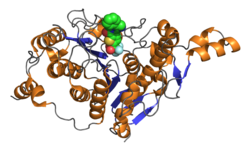Top Qs
Timeline
Chat
Perspective
HDAC4
Protein found in humans From Wikipedia, the free encyclopedia
Remove ads
Histone deacetylase 4, also known as HDAC4, is a protein that in humans is encoded by the HDAC4 gene.[5][6]
Remove ads
Function
Histones play a critical role in transcriptional regulation, cell cycle progression, and developmental events. Histone acetylation/deacetylation alters chromosome structure and affects transcription factor access to DNA. The protein encoded by this gene belongs to class II of the histone deacetylase/acuc/apha family. It possesses histone deacetylase activity and represses transcription when tethered to a promoter. This protein does not bind DNA directly but through transcription factors MEF2C and MEF2D. It seems to interact in a multiprotein complex with RbAp48 and HDAC3.[7] Furthermore, HDAC4 is required for TGFbeta1-induced myofibroblastic differentiation.[8]
Remove ads
Clinical significance
Studies have shown that HDAC4 regulates bone and muscle development. Harvard University researchers also concluded that it promotes healthy vision: Reduced levels of the protein led to the death of the rod photoreceptors and bipolar cells in the retinas of mice.[9][10]
Interactions
HDAC4 has been shown to interact with:
- BCL6,[11]
- BTG2,[12][13]
- CBX5,[14]
- GATA1,[15]
- HDAC3,[5][16][17][18]
- MAPK1,[19]
- MAPK3,[19]
- MEF2C,[20][21]
- Myocyte-specific enhancer factor 2A,[22][23]
- Nuclear receptor co-repressor 1,[16][24]
- Nuclear receptor co-repressor 2,[16][24]
- Testicular receptor 2,[25][26]
- YWHAB,[17]
- YWHAE,[17][27] and
- Zinc finger and BTB domain-containing protein 16.[11][28]
See also
References
Further reading
External links
Wikiwand - on
Seamless Wikipedia browsing. On steroids.
Remove ads






